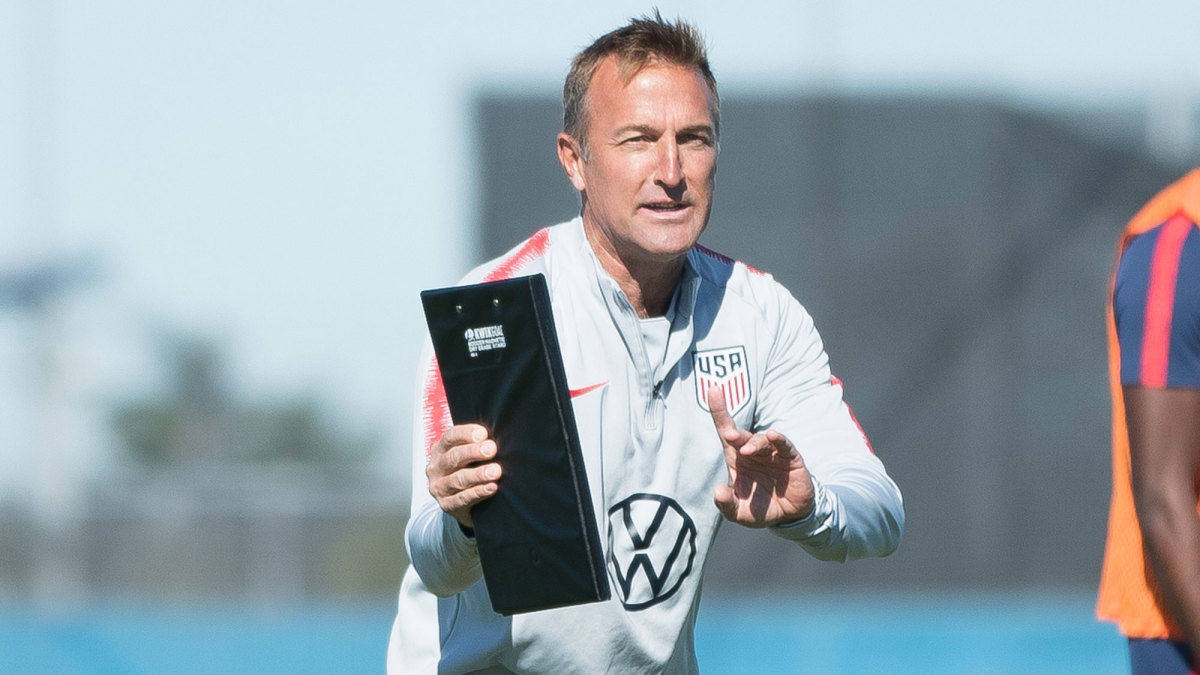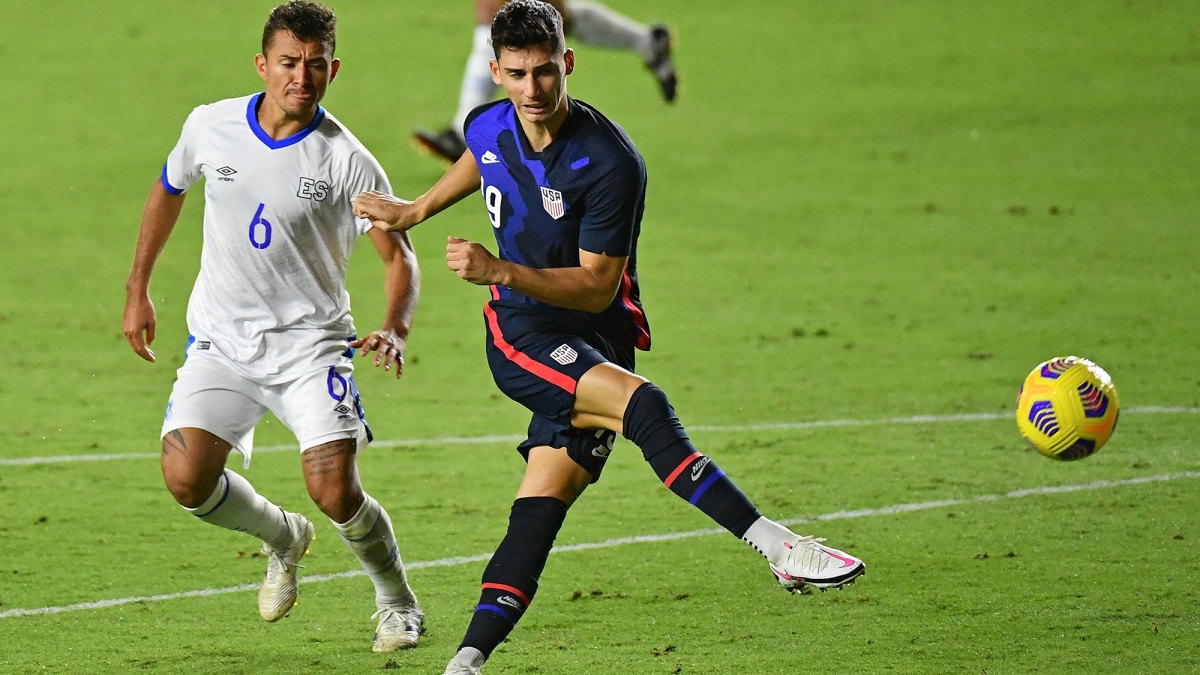Kreis Reveals USA's Final U-23 Olympic Qualifying Squad
Concacaf’s Olympic qualifying tournament originally was scheduled to kick off on March 20, 2020, and so it was among the first events to be lost entirely to the emerging pandemic. Coach Jason Kreis had selected his 20-man team, and it was training in Guadalajara ahead of its tournament opener when the world started grinding to a halt.
The pause has lasted almost exactly a year. Kreis and the U.S. U-23 national team are once again training in Guadalajara ahead of their postponed tournament debut, which is scheduled for March 18 against Costa Rica. And on Thursday, the coach unveiled the list of 20 men who will try to take the USA back to the Summer Olympics for the first time since 2008. There are players who were were part of the squad a year ago who persevered and earned their way back. But there are others who graduated, in a sense, moving onward and upward to European clubs and highlighting the fact that this particular U-23 team, while responsible for their country’s Olympic fate, is not at all a reflection of the state of the American player pool.
“There’s a host of players that weren’t available this year that were available last year,” Kreis said last week. “Ultimately it looks a little different from the top-end perspective perhaps. At the end of the day, I still feel very good about the talent level we have.”
Since the Olympics aren’t a senior FIFA event, clubs aren’t required to release their players. Teams in Europe that are in the middle of their seasons usually are reluctant to do so unless that player is a reserve. And even MLS teams can be uncooperative. Atlanta United pulled three men, including probable starting center back Miles Robinson, from Kreis’s training camp roster because it’s preparing for next month’s start of the Concacaf Champions League.

Last week, Kreis named a 28-man team to commence training Mexico. Eight players were released Thursday, reducing the tournament team to 20. The Americans will face Costa Rica, Dominican Republic (March 21) and Mexico (March 24) in the group stage, from which the top two finishers will qualify for the March 28 semifinals. The two semi winners will play for the title, which the USA has won once (1992), and qualify for the Olympics.
Kreis said last week that the program’s failures during the 2012 and 2016 cycles don’t represent a burden for the current group. Rather, they represent an opportunity to show how far U.S. soccer has come.
“I don’t think that any of us should feel any real onus about what has happened four years ago and eight years ago. None of us were part of that. For me, it’s to just kind of right some wrongs,” he said. “The other thing I think is really interesting about this situation with the men’s national team programs, really, us included, we have sort of the first opportunity to make a major step forward in qualifying for a major tournament, whereas the full team, they’ve got [World Cup] qualifying coming up at the end of the year. So, we kind of get the first bite at this and that’s another motivating factor.”
Twelve players on Kreis’s new list were part of the team in 2020. Among those on last year’s qualifying roster who no longer were available are Brenden Aaronson (Red Bull Salzburg), Reggie Cannon (Boavista), Chris Gloster (PSV Eindhoven) and Mark McKenzie (KRC Genk).
But those four represent just the tip of the generational iceberg. The USA theoretically could put together a U-23 (or U-24, because of the year delay) squad that likely would be a certainty to qualify and a medal contender this summer. Imagine Kreis taking a team to Guadalajara that featured Weston McKennie, Tyler Adams, Christian Pulisic, Gio Reyna, Sergiño Dest, Chris Richards, Timothy Weah, Josh Sargent, Antonee Robinson and Konrad de la Fuente. All are Olympic eligible. But they were never part of the U-23 picture because of how far they’ve progressed in their club careers. The U.S. team that’ll take the field next week represents the increased depth of the player pool and not its full potential.
But as Kreis said, he’s still optimistic about this group. Most players feature regularly for their clubs and 11—more than half— have earned caps at the senior level. After eight years of failure, excuses will be in short supply.
“We know that qualifying will be a challenge, but it’s a challenge that we’re ready for,” Kreis said in a Thursday statement. “We’ll need all 20 players on this roster to contribute for us to achieve our ultimate goal of qualifying for the Olympics. We’ve had a productive training camp in Guadalajara and our players are hungry for the opportunity to compete. After starting this journey nearly two years ago, we’re excited to get started with the tournament."
Here’s the team that will try to take the USA back to the Olympics:

GOALKEEPERS: Matt Freese (Philadelphia Union), J.T. Marcinkowski (San Jose Earthquakes), David Ochoa (Real Salt Lake)
DEFENDERS: Julian Araujo (LA Galaxy), Justen Glad (Real Salt Lake), Aaron Herrera (Real Salt Lake), Henry Kessler (New England Revolution), Mauricio Pineda (Chicago Fire), Sam Vines (Colorado Rapids)
MIDFIELDERS: Johnny Cardoso (SC Internacional), Hassani Dotson (Minnesota United), Ulysses Llanez (Heerenveen), Djordje Mihailovic (CF Montreal), Andrés Perea (Orlando City), Sebastian Saucedo (UNAM Pumas), Jackson Yueill (San Jose Earthquakes)
FORWARDS: Jesús Ferreira (FC Dallas), Jonathan Lewis (Colorado Rapids), Benji Michel (Orlando City), Sebastian Soto (Norwich City)
